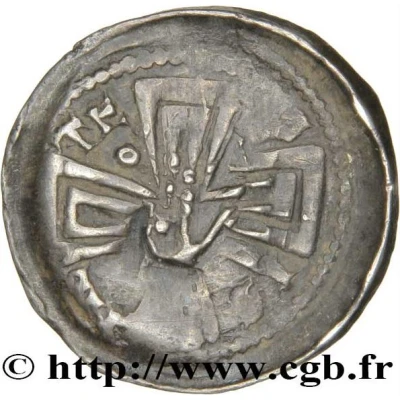


© pimmy (CC BY-NC-SA)
Denier - John I of Apremont 2nd type with crozier, small cross ND
| Silver | 0.7 g | 15.5 mm |
| Issuer | Bishopric of Metz (French States) |
|---|---|
| Bishop | John I of Apremont (1224-1238) |
| Type | Standard circulation coin |
| Years | 1224-1238 |
| Value | 1 Denier |
| Currency | Denier (929-1505) |
| Composition | Silver |
| Weight | 0.7 g |
| Diameter | 15.5 mm |
| Shape | Round (irregular) |
| Technique | Hammered |
| Orientation | Variable alignment ↺ |
| Demonetized | Yes |
| Updated | 2024-10-04 |
| Numista | N#35620 |
|---|---|
| Rarity index | 88% |
Reverse
Small cross pattée.
Script: Latin
Lettering: METENSIS
Translation: Metz.
Comment
Multiple varieties exist. They share the same Boudeau reference, but are divided in a major groups according to the Flon catalog (cf. comments). Some minor variations exist (with or without dots or stars, in front of or behind the bishop) and have no distinct number, so they won't be referenced here. However we can distinguish 2 main forms. This main form bears a small cross and the bishop with a stick. The other main form bears a completely different look, aka. a blessing hand over a bigger cross and a praying bishop).This main variation contains 4 secondary variations : the Flon#4 variation with only a cross ; the Flon#5 variation, actually on the picture (without the incuse strike), with 4 dots between cross branches ; the Flon#6 variation with 2 crescent moons and 2 stars alterning between the branches ; and an unreferenced variation with 4 crescent moons.
Interesting fact
One interesting fact about this coin is that it was minted during the reign of John I of Apremont, who was the Bishop of Metz from 1224 to 1238. The coin features a unique design, with a small cross and a crozier on the obverse, and a simple cross on the reverse. The use of a crozier, which is a staff with a curved top, is a symbol of the bishop's authority and highlights the coin's connection to the Bishopric of Metz. Additionally, the fact that it is made of silver and weighs only 0.7 grams suggests that it was a widely circulating coin, used for everyday transactions in the region.



